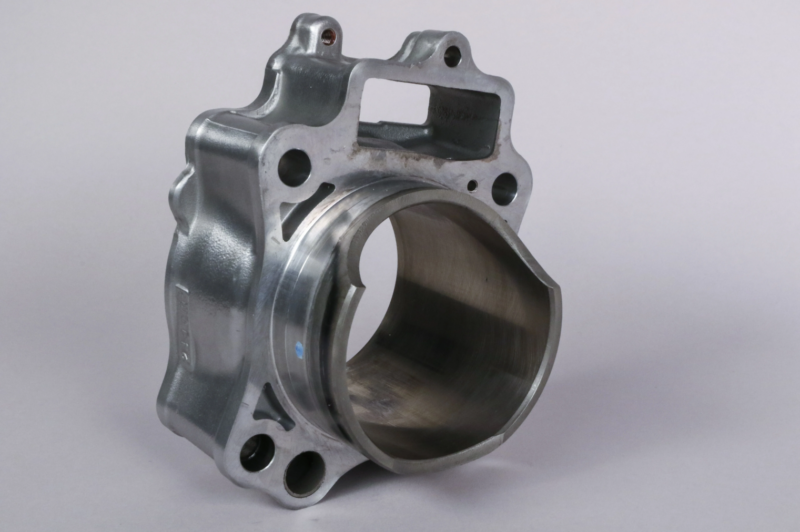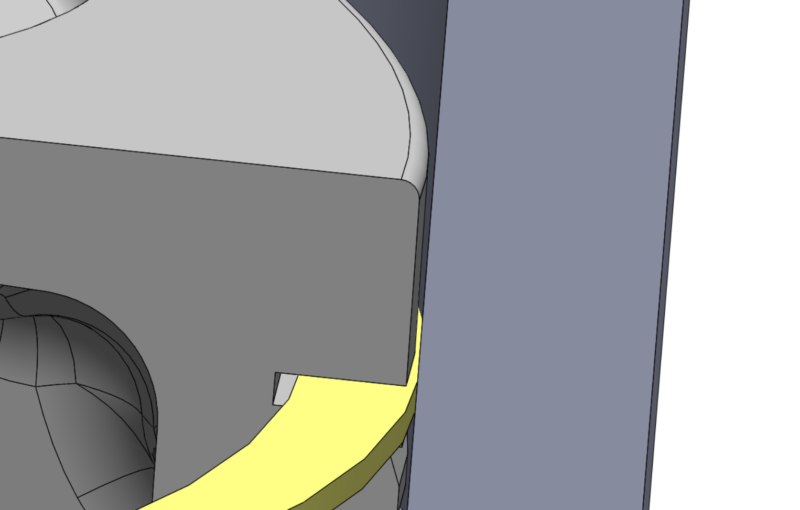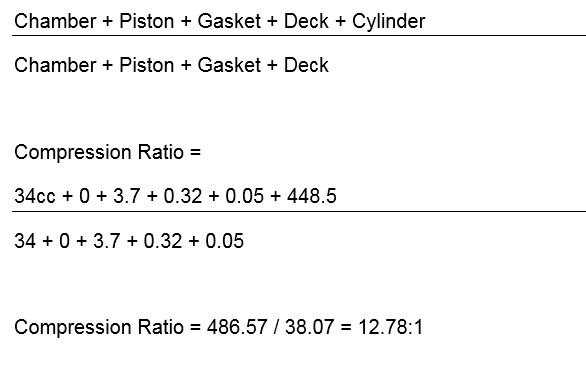Compression Ratio Theory and How to Calculate in Powersports
Whether you’re buying pistons for a motorcycle, ATV, or UTV, you’ll most likely see options in different compression ratios. A lot of factors go into designing pistons for different compression ratios. Here we’ll take a look how compression ratio is calculated, and how it can affect your engine, and race fuel requirements.
The formula is simple – compression makes power, and sometimes the “more is better” theory has some merit. But before we go blindly bumping compression ratios, it’s best to know more about how to get there. The compression ratio for any engine or individual cylinder is defined as the ratio between the swept volume of the cylinder with the piston at bottom dead center (BDC) and the volume with the piston at top dead center (TDC). If, for example, the relationship of the BDC volume is 13 times larger than the volume at TDC, then the compression ratio is 13:1.


Compression ratio is the ratio between the swept volume of the cylinder with the piston at bottom dead center and the swept volume of the cylinder with the piston at top dead center.
Compression ratio is instrumental in making power, since it is this squeezing of the air-fuel mixture that enhances the combustion process and makes power. Of course, higher compression also places a greater octane requirement on the fuel, so it’s important to keep that in mind. We’ll use single-cylinder dirt bike engines as an example. Production dirt bike engine compression ratios have increased over the years, to current ranges of around 12.5:1 to 13.5:1, while still capable of burning pump premium 91 / 93 octane gasoline. This is accomplished by better combustion space design, as well as superior air-fuel ratio control through electronic fuel injection (EFI).
How is compression ratio calculated?
It might be a good idea to review how compression is calculated. This is a matter of breaking down a series of small areas that need to have their individual volumes calculated. Then, these smaller volumes can be added together to create the overall swept volume. For example, the area on top of the piston at TDC must take into account the individual volumes of the chamber, the top of the piston (the crown design), the head gasket, and the height of the piston above or below the deck of the cylinder.
Click here to read about how to calculate compression and displacement for automotive engines.
Cylinder Volume

Calculating the cylinder volume with Pi x radius squared x stroke gives you the volume of the cylinder only. Pictured here is a single cylinder off a 250F motorcycle.
Our first step is to determine the volume of the cylinder based on bore and stroke. If you recall from high school geometry, Volume of Cylinder = Pi x radius squared x height (in this case, stroke). With a 77mm bore and a 53.6mm stroke, this creates a cylinder with a volume of 249cc’s. This is just the cylinder itself.
Next, we need to know the volume of the combustion chamber. The easiest way to measure this is with a graduated cylinder or burette. Most burettes are graduated in milliliters, and one milliliter is equal to one cubic centimeter (cc), so don’t let that throw you. Chamber volume has a direct impact on compression ratio, so measuring this is important for accuracy. A square plexiglass lid sealed with grease with a small hole drilled in it to allow you to fill the chamber with rubbing alcohol mixed with a little food coloring works well as a measuring fluid.
We use an automotive cylinder head in the example below, but the same process can be done for single or multi-cylinder motorcycle engines.

Sealing a plexiglass lid over the combustion chamber with grease will allow you to fill the combustion chamber with rubbing alcohol. You can use an electronic measuring tool to find the volume of the liquid, or you can calculate manually with a graduated cylinder.

Be sure the combustion chamber is filled completely, with no air bubbles, to reach an accurate measurement.
Piston Volume
The piston volume must also be measured. This is important, since rarely is the piston perfectly flat. If it were, the piston volume number would essentially be 0, or one that neither adds nor subtracts from the compression ratio. However, most piston tops contain some combination of valve reliefs, a dish, or a dome configuration that constitute a given volume. Let’s say that that piston offers a slight dome, but also includes piston valve relief. The piston’s overall dome volume needs to be calculated to reach an accurate compression ratio. Your piston manufacturer should have this volume available when you need it. JE Pistons keeps this information on record with each piston design.
Keep in mind that even seemingly small changes can have a direct effect on compression. For example, increasing the bore diameter by even just 2mm – from 96 to 98 mm, for example – with no other changes to a the piston, will bump a 13.58:1 compression ratio to 14.05:1, simply because the piston area is now larger.
Dome volume also takes into account something called crevice volume, or the tiny volume found between the top edge of the piston above the ring land and the cylinder wall. This measurement is most important to perform if the piston has been modified to add additional valve relief clearance or if other modifications to the piston top have been performed.
This volume is very minimal, but it’s something JE takes into account when calculating compression to make sure high accuracy is maintained.


Crevice volume measures the small amount of space between the top, outer edge of the piston (above the top ring) and the cylinder. You can see this small space pictured above.
Head Gasket
The head gasket thickness also affects compression, as this also creates a volume that must be included in the calculation. A thick head gasket essentially adds volume to the chamber, while a thinner gasket reduces it. The volume calculation is the same as a cylinder – just very short. Most often, the gasket inside diameter is round, so calculating the volume is fairly simple: Volume = Pi x radius squared x height.
Deck Height
Deck height must also be taken into account. If the piston at TDC is short of the cylinder deck, then this volume is added to the combustion chamber volume, reducing the compression ratio. If the piston top exceeds the top of the cylinder by a given amount, this volume must be subtracted from the combustion chamber volume, which will increase the compression ratio. This piston position also directly affects piston-to-head clearance, so carefully monitor this to stay within specs.

Once all these dimensions have been determined, we can do the simple math of dividing the volume of cylinder with the piston at the bottom of its stroke by the volume of the cylinder with the piston at the top of its stroke. We have included the entire math formula here at the bottom of this page, but it is overly long and complex, and there’s really no reason to go through all of that unless you really like long-hand calculations! The simpler version is to use one of the many free, on-line compression ratio calculators.

We like the version offered from Performance Trends (Performancetrends.com) as it is easy to use and can be downloaded for free. Inputs to this program can even be changed from English to metric if you prefer, and the inputs are so easy to make that you can try dozens of different combinations to satisfy your curiosity.
It’s important to note that while compression does play an important role in making power, adding compression is not a purely linear proposal. The generally accepted gauge for adding compression is that one full point of compression can add between 3 to 4 percent power. So, if an engine is making 50 horsepower and we add a full point of compression (from 11 to 12:1 for example), this could potentially push the power to 51.5 horsepower. However, with current race engine compression ratios already at 13:1 levels, adding a full point of compression may not necessarily add a full three percent, as the law of diminishing returns plays a part with ratios nearing 14:1 or higher. There will still be a positive gain, but it will likely not be as great as the gain, for example, from 9:1 to 10:1.


Pictured here are 3 different compression ratio JE pistons for the same YXZ1000 motor. The CRs include 9.5:1 (dished for less compression for turbo applications), 11.5:1 (std compression), and 12.5:1 (high compression). Notice the highest compression has the tallest dome features, taking up more of the combustion chamber volume. The 9.5:1 piston is the opposite.

Should I be running race gas?
With most of the new motorcycle engines now pushing 13:1 static compression ratios, these engines are running very finely-tuned combinations to allow them to run on 91 to 93 octane pump gas. One question that is often asked is whether running race gasoline would be of benefit. There are several factors that come into play with race gasoline that go far beyond just the increase in octane rating. Many racers feel that adding octane will also add power. While this can be true, the answers can be difficult to decipher.
Octane, by itself is not a function of fuel that adds power. Octane is added to fuel to prevent detonation. If the engine suffers from detonation or knocking due to the use of a lower grade gasoline, adding octane will restore that power. Conversely, adding a higher octane rated fuel to an engine that is not suffering from detonation problems will not result in additional power. A more common situation is that adding octane beyond the engine’s requirements generally results in a less efficient combustion process that does not increase power. In certain situations, use of too much octane can result in a slight loss of power! Here is where the “More is Better” theory fails the test.
Much like every other system in a race engine, it is the proper combination of components and fuel that can result in improved power. For example, race gasoline is often blended with oxygenates which have the effect of leaning / changing the fuel’s stoichiometric (or chemically correct) air-fuel ratio. It is often these additives that are responsible for power increases, and not the octane number. Experimenting with fuels with different oxygenate percentages can have a dramatic effect on the actual air-fuel ratio. This gets into a complex story on stoichiometric air-fuel ratio that is beyond the focus of this story, but it is an important issue to be aware of before attempting to custom blend race gasoline.
Compression can be an easy way to improve power, but you need to be up on your game when it comes to choosing the right parts. Running the numbers through a compression ratio program is probably the easiest way to make sure the numbers don’t get out of control.
Compression Ratio Calculation Example

